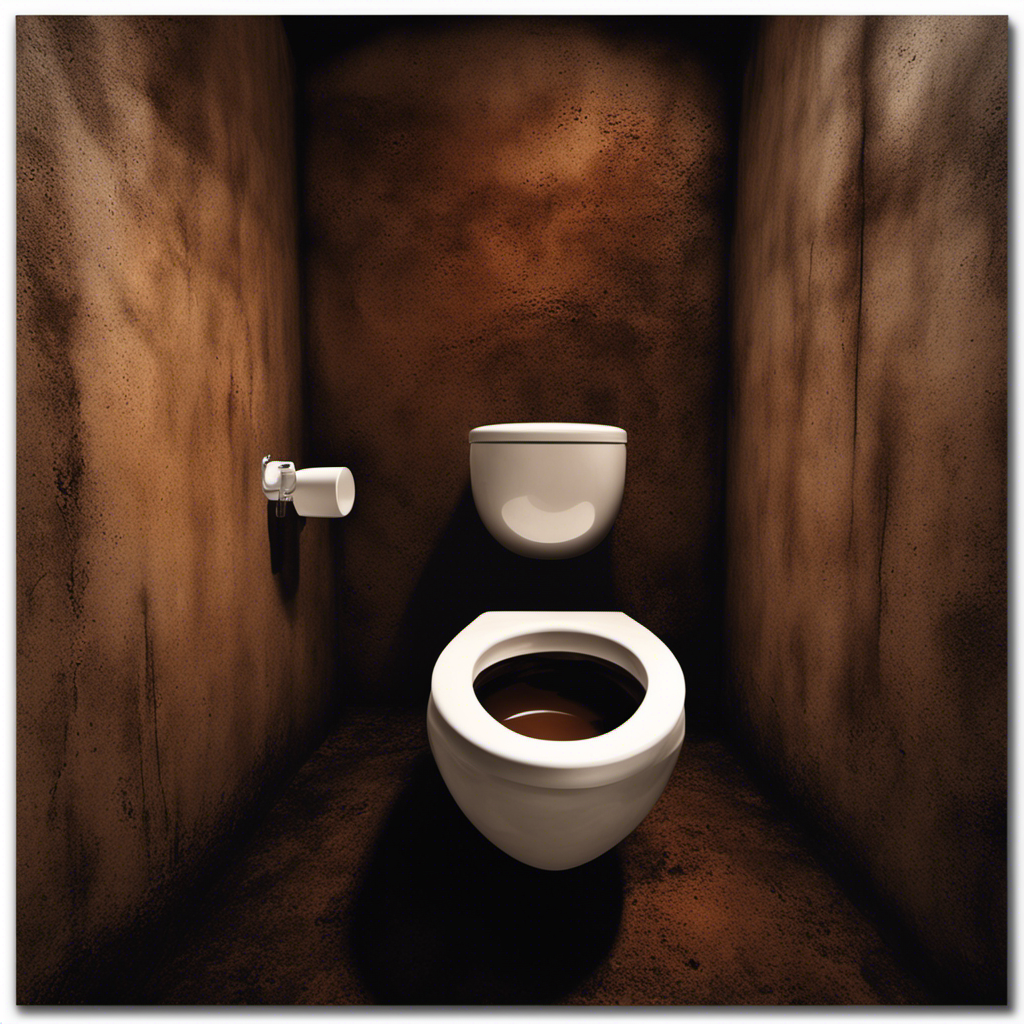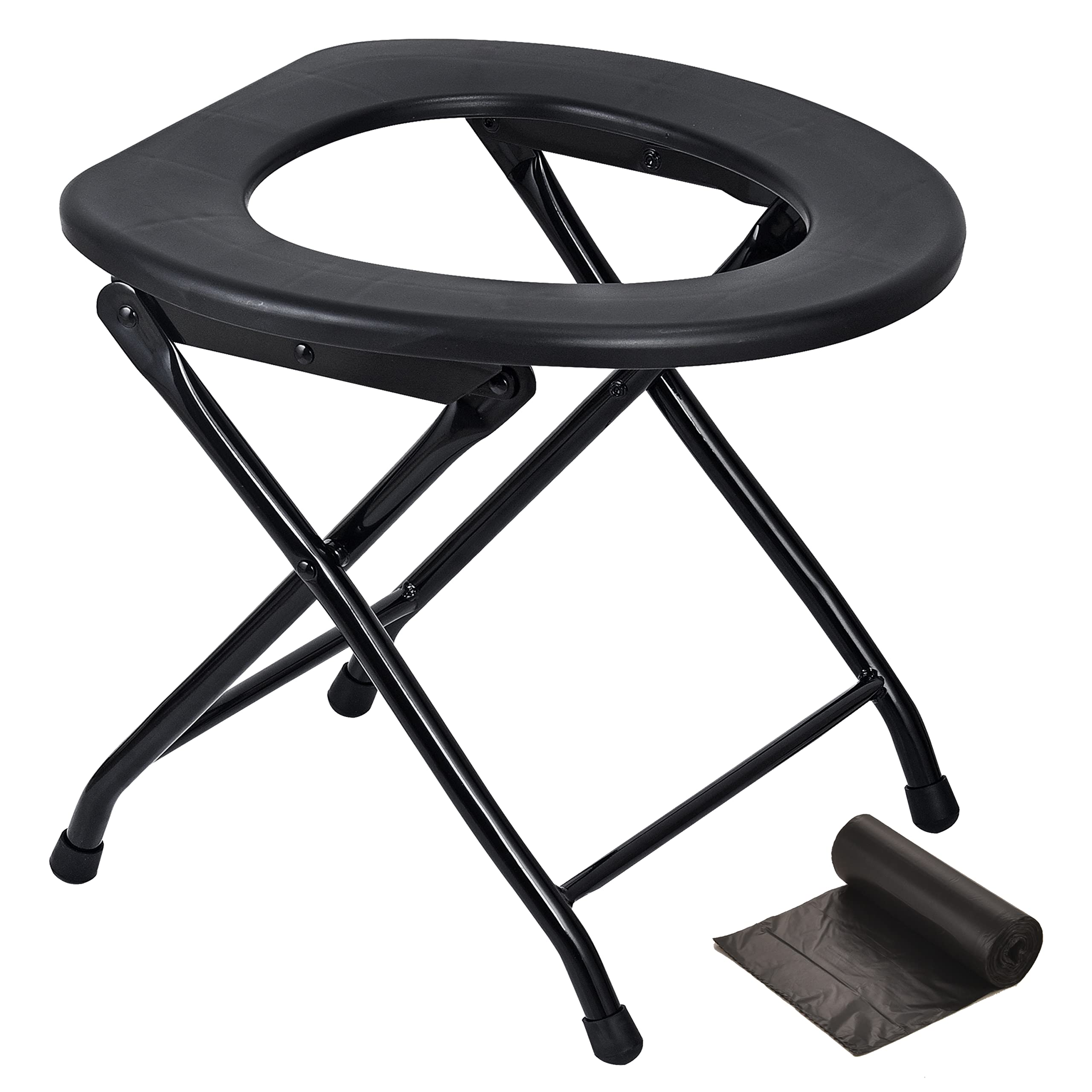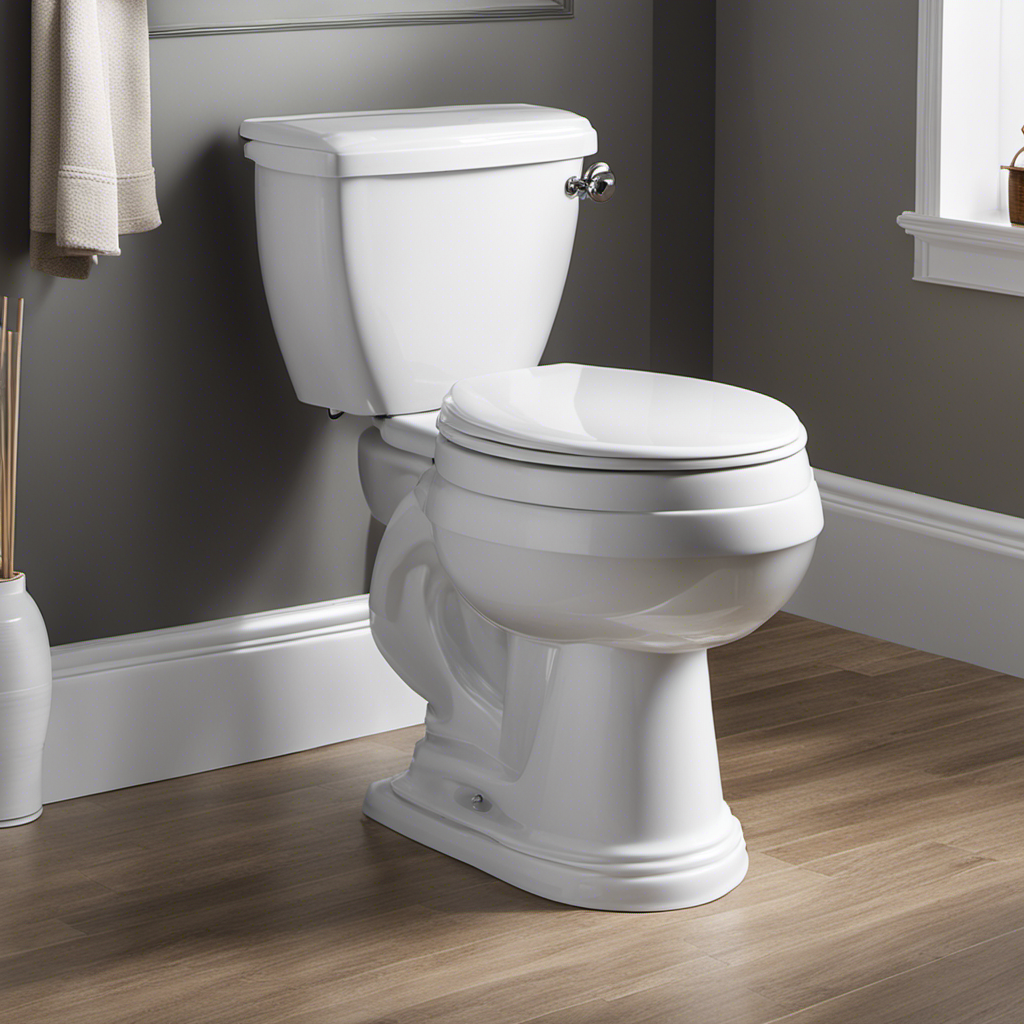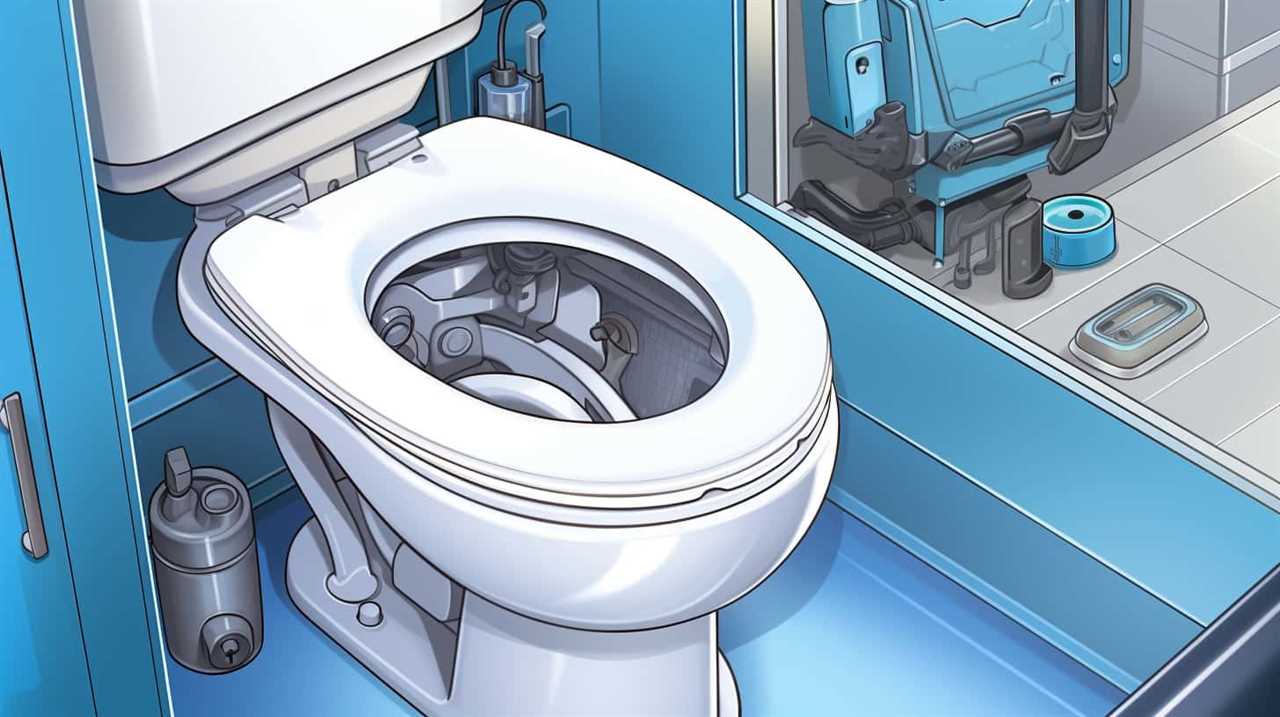As someone who has experienced the alarming sight of brown water in my toilet, I understand the urgency to find answers.
In this article, we will delve into the possible causes of this unsettling phenomenon and explore how to determine if the water is safe for use.
We will also examine the impact of rust on toilet water color and identify common plumbing issues that can lead to brown water.
By the end, you’ll be equipped with the knowledge and steps to fix and prevent brown water in your toilet.
Key Takeaways
- Brown toilet water can be caused by rusty pipes, sediment buildup, a malfunctioning water heater, or a contaminated water supply.
- Ingesting rust particles from brown water can irritate the gastrointestinal tract, and long-term exposure may increase the risk of health conditions.
- To determine the safety of brown water, one should check for unusual odor, examine water appearance, and perform a water testing kit.
- Preventive measures to fix brown toilet water include regularly flushing out pipes, checking for rusty pipes and replacing affected ones, considering water treatment options, and regularly cleaning and maintaining the toilet.
Possible Causes of Brown Toilet Water
One possible cause of brown toilet water could be a problem with the plumbing system. Water discoloration can occur due to various reasons, such as rusty pipes, sediment buildup, or a malfunctioning water heater.
Rust from old pipes can leach into the water, causing it to turn brown. Sediment buildup in the pipes can also contribute to water discoloration. Additionally, a faulty water heater can release rust particles into the water supply, resulting in brown water.
The effects of brown water can be unsightly and may stain porcelain surfaces. It can also raise concerns about the quality and safety of the water. To determine if the brown water is safe to use, it is important to investigate further and consider testing the water for contaminants.
How to Determine if the Brown Water Is Safe to Use
To determine if the brown water is safe to use, you can start by checking if there is any unusual odor present. If the water has a foul smell, it could be an indication of contamination.
Another way to test water quality is by examining its appearance. Cloudy or discolored water may suggest the presence of impurities.
Additionally, you can perform a simple test using a water testing kit. These kits are designed to detect various contaminants such as bacteria, lead, and chemicals. By following the instructions provided with the kit, you can get a better understanding of the water’s safety.
It’s important to address signs of contaminated water promptly to ensure the health and well-being of yourself and your family.
Understanding the Impact of Rust on Toilet Water Color
Rust in toilet water is a common issue that many people encounter. It occurs when iron particles from corroded pipes mix with the water supply, causing the water to turn a brownish color.
While this discoloration may not pose an immediate health risk, it is important to understand the potential dangers of rust and address the underlying issue to ensure the safety of the water supply.
Rust Causing Brown Water
Did you know that rust can cause your toilet water to turn brown?
Rust is a common problem in plumbing systems, and its presence can have a significant impact on water quality. When metal pipes corrode, they release iron oxide particles into the water, giving it a brownish color.
This can be especially noticeable in toilets, where water is constantly flowing and any sediments become more apparent.
To prevent corrosion and avoid brown water, it is essential to implement proper corrosion prevention measures. This includes using corrosion-resistant materials for plumbing pipes, regular maintenance and inspections, and installing water treatment systems if necessary.
Health Risks of Rust
Corroded metal pipes can pose health risks due to the presence of rust particles in the water supply. When water flows through these corroded pipes, it can pick up rust and become discolored, resulting in what is commonly known as rusty water.
The health effects of consuming rusty water can vary depending on the concentration and type of rust particles present. Ingesting rust particles can irritate the gastrointestinal tract, leading to symptoms such as stomach pain, nausea, and diarrhea. Furthermore, long-term exposure to rusty water may increase the risk of developing certain health conditions, such as gastrointestinal disorders and iron overload.
To minimize these health risks, it is essential to address the underlying cause of the rust, such as repairing or replacing corroded pipes, and ensuring that the water supply is properly treated and filtered.
Common Plumbing Issues That Can Lead to Brown Water
As a plumbing expert, I can shed some light on the common plumbing issues that can lead to brown water in your home.
One of the main culprits is rusty pipes, which can cause discoloration in your water supply. This occurs when the inner lining of the pipes deteriorates over time, allowing rust particles to mix with the water.
Another potential cause is a contaminated water supply, which can introduce various impurities into your plumbing system.
Lastly, sediment buildup in your plumbing can contribute to brown water by trapping particles and minerals, which can then be released into the water supply.
Rusty Pipes Causing Discoloration
The brown color of your toilet water could be due to rusty pipes. Rust is a common issue in plumbing systems, and it can cause discoloration in your water.
Rust occurs when iron pipes corrode over time, due to exposure to oxygen and moisture. This corrosion creates iron oxide, which gives the water a brownish tint.
To prevent discoloration caused by rusty pipes, regular plumbing maintenance is crucial. This includes inspecting pipes for signs of corrosion, addressing any leaks or drips promptly, and replacing corroded pipes when necessary.
Additionally, using a water softener can help prevent mineral buildup that can exacerbate rusting.
Contaminated Water Supply
Moving on from the discussion on rusty pipes causing discoloration in toilet water, let’s now delve into the issue of contaminated water supply.
Contaminated water sources refer to any water supply that contains harmful substances or pathogens. This can occur due to various factors, such as industrial pollution, agricultural runoff, or inadequate water treatment processes.
Consuming contaminated water can have severe health effects on individuals. It can lead to gastrointestinal illnesses, such as diarrhea and vomiting, as well as waterborne diseases like cholera and typhoid fever. Additionally, exposure to certain contaminants, such as heavy metals or chemicals, can have long-term health implications, including organ damage or an increased risk of cancer.
Therefore, it is crucial to ensure that our water sources are properly monitored and treated to minimize the risks associated with contaminated water.
Sediment Buildup in Plumbing
To prevent sediment buildup in your plumbing, it is important to regularly flush out your pipes. Sediment can accumulate over time and cause blockages, leading to reduced water flow and potential damage to your pipes. Here are some key reasons why you should prioritize flushing out your pipes:
-
Prevent pipe corrosion: Sediment buildup can contribute to the corrosion of your pipes, which can lead to leaks and other plumbing issues.
-
Improve water quality: Sediment can contain various impurities that affect the taste and odor of your water. Flushing out your pipes helps remove these contaminants and ensures cleaner, fresher water.
-
Maintain water pressure: Sediment can restrict the flow of water through your pipes, resulting in low water pressure. Regular flushing helps maintain optimal water pressure throughout your plumbing system.
-
Extend the lifespan of your pipes: By preventing sediment buildup and corrosion, regular pipe flushing can help prolong the lifespan of your plumbing system, saving you time and money on repairs.
Steps to Take to Fix Brown Toilet Water
First, you should check if the brown toilet water is caused by rusty pipes. Toilet water discoloration can be a result of sediment buildup in the plumbing system, which can lead to rust particles entering the water supply.
To fix this issue, you can start by inspecting the pipes for signs of corrosion or rust. If you find any, it’s recommended to replace the affected pipes to prevent further discoloration.
Additionally, you may consider implementing water treatment options to improve the quality of your toilet water. These options include using a water softener to reduce mineral content and installing a filtration system to remove impurities.
It is also essential to regularly clean and maintain your toilet to prevent any buildup or discoloration.
Preventive Measures to Avoid Brown Water in the Toilet
Now that we have discussed the steps to fix brown toilet water, let’s move on to preventive measures to avoid this issue altogether.
By following these maintenance tips, you can ensure that your toilet water remains clear and free from discoloration:
-
Regular cleaning: Regularly clean your toilet bowl using a toilet cleaner to prevent the buildup of stains and bacteria.
-
Proper flushing: Always flush the toilet properly to prevent any residue from accumulating in the bowl.
-
Check the water source: If your toilet water is consistently brown, check the water source for any issues such as rust or sediment buildup.
-
Plumbing inspection: Periodically inspect your plumbing system to identify and address any potential problems that may affect the quality of your toilet water.
When to Seek Professional Help for Brown Toilet Water Issues
If you’re experiencing persistent discoloration in your toilet bowl, it might be time to consider professional assistance.
While there are DIY solutions available to tackle minor issues, seeking professional advice can help identify and resolve more complex problems.
Brown water in the toilet can be caused by a variety of factors, such as rusty pipes, sediment buildup, or even an issue with the water supply.
A professional plumber can perform a thorough inspection to pinpoint the exact cause and provide a tailored solution. They have the expertise and specialized tools to address the issue effectively, ensuring long-lasting results.
Additionally, professional assistance can help prevent further damage to your plumbing system, saving you time, money, and frustration in the long run.
Frequently Asked Questions
Can Brown Toilet Water Be Harmful to Our Health?
Brown toilet water, while unsightly, may not necessarily be harmful to our health. However, it could indicate potential risks such as contamination or issues with water quality standards. It is important to investigate the cause and take appropriate measures.
How Can I Determine if the Brown Water Is Caused by Rust or Another Factor?
Determining the cause of brown toilet water can be tricky. To test for rust, try using a water testing kit. It’s important to identify the source of the discoloration to ensure your water is safe.
What Are Some Common Plumbing Issues That Can Result in Brown Water?
Common causes of brown water in toilets can include rust in pipes, sediment buildup, or a problem with the municipal water supply. Plumbing solutions may involve flushing the system, installing a water filtration system, or contacting a professional plumber for further assistance.
What Steps Can I Take to Fix Brown Toilet Water?
To fix brown toilet water, I would first check for any plumbing issues such as rusty pipes or sediment buildup. Then, I would flush the toilet multiple times to clear out any debris. If the problem persists, it may be best to call a professional plumber.
Are There Any Preventive Measures I Can Take to Avoid Brown Water in the Toilet?
To prevent brown water in the toilet, I recommend regularly cleaning and maintaining the plumbing system. This will help remove any potential causes, such as rust or sediment buildup, ensuring clear and clean water.
Conclusion
In conclusion, discovering why my toilet water is brown has been an enlightening and somewhat amusing journey. Who would have thought that something as simple as rust or plumbing issues could lead to such a perplexing and ironic situation?
While the steps to fix brown toilet water are straightforward, it’s essential to remember the preventive measures to avoid this situation altogether. However, if all else fails, don’t hesitate to seek professional help. Because, let’s face it, sometimes even the most knowledgeable and technical individuals need a little assistance with their brown toilet water woes.










